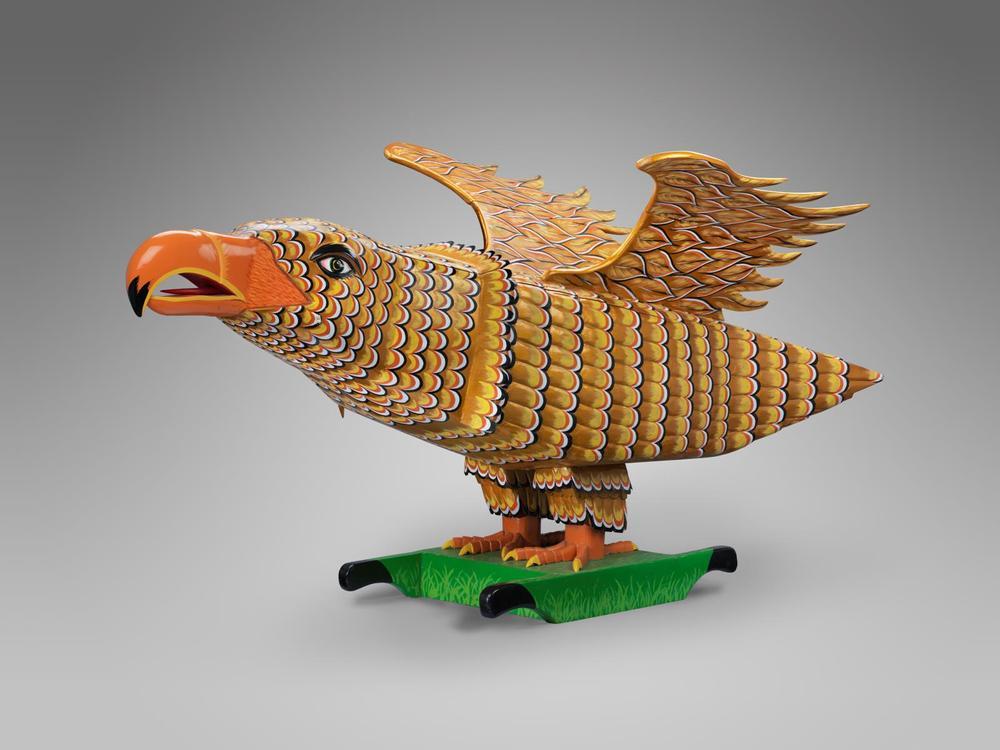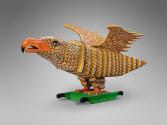Advanced Search
Joseph Tetteh-Ashong, best known as Paa Joe, created this coffin in the shape of an eagle with wings outstretched for the MFA collection. He belongs to the second generation of artists making so-called 'fantasy coffins' or 'proverbial coffins' for wealthy families, in forms that evoke the life of the deceased—such as a tomato for a tomato farmer, a chicken with many chicks for a mother of a large family, or a Mercedes car for a businessman. Paa Joe trained with his uncle, Seth Kane Kwei (born 1925/30, deceased 1992), a celebrated practitioner of the form, and opened up his own workshop in 1976. He began exhibiting his work in art museums in 1989 while continuing his coffin business in Accra.
The eagle is meaningful to two different sets of contemporary patrons. The powerful creature has long been a symbol of chiefly authority among the Ga, a community that settled on the Accra coast in the sixteenth century and are celebrated fishermen and boat-builders today. Figurative coffins likely developed out of lion-shaped palanquins that held Ga chiefs aloft during special events, a form first used in Accra in the 1930s. The eagle is also meaningful for Christians, due to its association with St. John; beginning in the 19th century, many Ghanaians converted to Christianity. Church burial grounds often require that believers be buried in a simple coffin, but will sometimes allow a coffin in the shape of a Bible or an eagle.
This coffin was intended for display. The eagle is shaped and painted like a coffin made for burial, but it is crafted out of harder and more durable wood to assure its longevity above ground. The MFA chose the eagle motif because it is as recognizable to an American visitor as to a Ghanaian audience—as a motif conveying leadership and excellence, as well as a common symbol on Christian pulpits throughout the city of Boston. The eagle is also one of Paa Joe’s best-known forms, and includes the finely worked curves and detailed painting that is a hallmark of his sculptures.
Fantasy coffin (abebui adera) in the form of an eagle
Pobiman, Greater Accra, Ghana
2017
Object Place: Accra, Ghana
Medium/Technique
Wood
Dimensions
Overall (with wings folded): 132.1 × 91.4 × 287 cm (52 × 36 × 113 in.)
Credit Line
Museum purchase with funds donated by Deborah Glasser
Accession Number2017.4436
CollectionsContemporary Art, Africa and Oceania
ClassificationsTomb equipment – Coffins and sarcophagi
Joseph Tetteh-Ashong, best known as Paa Joe, created this coffin in the shape of an eagle with wings outstretched for the MFA collection. He belongs to the second generation of artists making so-called 'fantasy coffins' or 'proverbial coffins' for wealthy families, in forms that evoke the life of the deceased—such as a tomato for a tomato farmer, a chicken with many chicks for a mother of a large family, or a Mercedes car for a businessman. Paa Joe trained with his uncle, Seth Kane Kwei (born 1925/30, deceased 1992), a celebrated practitioner of the form, and opened up his own workshop in 1976. He began exhibiting his work in art museums in 1989 while continuing his coffin business in Accra.
The eagle is meaningful to two different sets of contemporary patrons. The powerful creature has long been a symbol of chiefly authority among the Ga, a community that settled on the Accra coast in the sixteenth century and are celebrated fishermen and boat-builders today. Figurative coffins likely developed out of lion-shaped palanquins that held Ga chiefs aloft during special events, a form first used in Accra in the 1930s. The eagle is also meaningful for Christians, due to its association with St. John; beginning in the 19th century, many Ghanaians converted to Christianity. Church burial grounds often require that believers be buried in a simple coffin, but will sometimes allow a coffin in the shape of a Bible or an eagle.
This coffin was intended for display. The eagle is shaped and painted like a coffin made for burial, but it is crafted out of harder and more durable wood to assure its longevity above ground. The MFA chose the eagle motif because it is as recognizable to an American visitor as to a Ghanaian audience—as a motif conveying leadership and excellence, as well as a common symbol on Christian pulpits throughout the city of Boston. The eagle is also one of Paa Joe’s best-known forms, and includes the finely worked curves and detailed painting that is a hallmark of his sculptures.
Provenance2017, commissioned from the artist by the MFA. (Accession Date: December 14, 2017)
CopyrightReproduced with permission.





